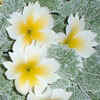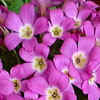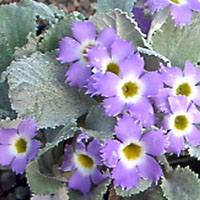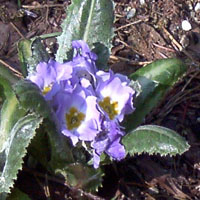|
Primula
‘Netta Dennis’
by
Susan Tindall
|
|
|
|
Primula
‘Netta Dennis’ is a plant that is often seen
at the spring shows of the AGS & SRG, and is
indeed a show stopper; mealy green grey leaves,
and the beautiful pale lemon flowers with the
dark yellow centre.
I
have struggled with this plant; there are times
when I would have amply enough plants to place
it in my plant list, then there are other times,
like now when I am down to just a few plants.
|
|
|
| A
Mr. John Dennis from Doncaster in Yorkshire bred
the plant. The cross he made was by Primula
aureata (yellow) from central Nepal ‘to the
north of Kathmandu’, and Primula petiolaris
that has pink flowers and is found growing in
its natural habitat of Nepal and Sikkim, recorded
to be growing at around 2100m to 3800m.
|
 |
 |
|
|
|
|
Knowing
where the Primula grow, gives you some idea as
to what growing condition Asiatic Primula like
and is not always easy to copy in the garden
especially if the summers are warm and dry.
In
2006 in Ireland we did have what you might call
‘a bit of summer’, few weeks of high
temperatures for us. I grow the easy petiolaris
primula in the garden where the ground never
dries out, as we do have spring wells on our
land, which can be an advantage or disadvantage
depending on what you wish to grow.
|
|
|
|
|
|
| I have never
been brave enough to plant out Primula aureata,
P. nana (edgeworthii) or Primula ‘Netta
Dennis’ and have kept them in pots, under
glass, at the cool end of the glasshouse with
the louvres open all the time. Even these plants
were beginning to suffer with the heat, and
constant watering is not a help as the root
becomes very hot, the plant does not seem to
take up any water, and it begins to look sad and
then it dies. The plants were beginning to send
messages to me like ‘help’, so drastic
action had to be taken. In the part of the
garden close to the nursery we do have a
woodland garden about one and half acres. We
created it ourselves, planting the trees over
thirty years ago.
|
 |
|
P.
edgeworthii |
|
|
|
 |
These trees are now of a good
height, and I am able to underplant with
Meconopsis, hardy orchids, Dicksonia, Erythronium, Wood anemone etc., and this is
where I have now planted out the Asiatic Primula.
Primula
sonchifolia is another beautiful Asiatic Primula,
flowering time March - April. This
plant will not tolerate dry conditions, it must
be planted with the roots in water, if not you
will certainly lose this lovely plant. In
the winter the plant has a large resting bud,
almost egg-like, and in early March the
flowers emerge on a short stout flowering stem .
I
am fortunate enough to be able to grow this
plant as I do have water in the garden and
plenty of damp areas.
|
|
|
|
|
I
did it when the temperatures were high, and I
have to say the plants are looking good coming
into winter, and the plants have put on growth.
The two trees they are growing under are Picea
abies and Pseudotsuga menziesii giving light
shade. Planted over thirty years ago, only
whips, they are now more than 15m; the ground at
the start was very dry, as the trees had thrown
a lot of shade before the bottom branches had
been taken off and had stopped the rain coming
through the canopy of branches, and another
observation is that the needles from the trees
form a matting; this also prevents rain
penetrating into the soil. The ground was dug
over, and I have covered to whole area with bark
chippings, it was sprayed thoroughly to dampen
the chips and the soil underneath the bark
chips. I can report I saw some frogs hopping
over this area, and if they are there it must be
damp, also they will eat the slugs.
Preparing
Primula ‘Netta Dennis’ for the show benches,
I would recommend the plant is kept in a cold
frame or a cold glass house, for a least 8 weeks
before the show, the reason for this, you do not
want water on the foliage of the plant as the
farina will be washed off, and the plant will
not look so attractive, I also suggest you top
dress with fine bark rather than grit; it sets
the plant off better.
|
|
|
|
